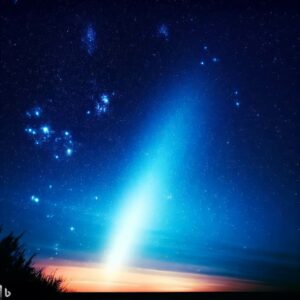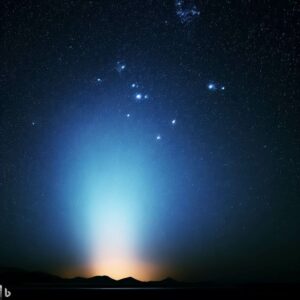Stargazing enthusiasts and astronomy aficionados should brace themselves for an impressive celestial spectacle this September! NASA has shared skywatching tips, with special emphasis on looking out for “zodiacal light“, an unusual phenomenon which will brighten our night skies in many ways. So grab your telescopes and binoculars as we take in what the heavens have in store this month!

Zodiacal Light : A Cosmic Phenomenon
Let’s begin our tour de force: the zodiacal light. This captivating celestial event occurs when sunlight scatters off interplanetary dust particles gathered along our solar system’s plane known as the ecliptic. As a result, an orange pyramid-shaped glow emanates upward from the horizon shortly after sunset or before dawn and forms on an ascending gradient across it all.
Where and When Will It Occur?
Evening Viewing: In the evening after sunset, observers in the northern hemisphere can catch an amazing display: Zodiacal Light in western sky for approximately one hour after sun has set below horizon. This event provides great viewing opportunity!
Morning Viewing: For early risers who like waking early in order to catch sunrise in its eastern sky, pre-dawn hours provide another opportunity to witness this celestial phenomenon.
Dark Skies To best experience the zodiacal light, look for locations free from urban light pollution – rural settings that offer uninterrupted horizon views can provide this unforgettable view.

Planetary Parade
In September, keep a lookout for several planets as they pass over our night skies! Keep an eye out for these celestial inhabitants:
Jupiter and Saturn: Both gas giants will be prominent features in the evening sky. Jupiter, our largest planet in our solar system, stands out against its background stars to give an evening show as it often appears visible even from urban settings; Saturn with its iconic rings doesn’t lag far behind either!
Mars can easily be observed during predawn hours due to its characteristic reddish hue, making it easy for observers to spot.
Venus can still be seen low in the western sky shortly after sunset; although not as prominent.
September isn’t all zodiacal light and planets; September also provides us with meteor showers: a rare treat indeed!
Aurigids (August 28 – September 5): While its peak period typically occurs from late August until early September, you might still catch some meteors lingering around early September if looking toward Auriga as this constellation offers you your best chances to spot these shooting stars.
Southern Taurids (September 10 – November 20)
Although not the most prolific meteor shower, the Southern Taurids may produce bright, slow-moving meteors – ideal viewing time is after midnight.
An Interesting Celestial Trio of Moon, Jupiter and Saturn
On September 14th and 15th, an extraordinary celestial trio will form in the evening sky: crescent moon, Jupiter, and Saturn will assemble close together, offering an excellent opportunity for astrophotography or telescope observation.
Conclusion
September brings skywatchers an abundance of celestial delights. The “zodiacal light” with its mysterious glow takes center stage while Jupiter, Saturn, Mars and Venus offer stunning panoramas as backdrops. Don’t forget meteor showers and meteor showering! Also look out for meteor showers along with moon, Jupiter and Saturn formations! As nights grow longer take advantage of clear skies to embark upon your own cosmic voyage using NASA skywatching tips as your guide through exploring all that September offers skygazers!